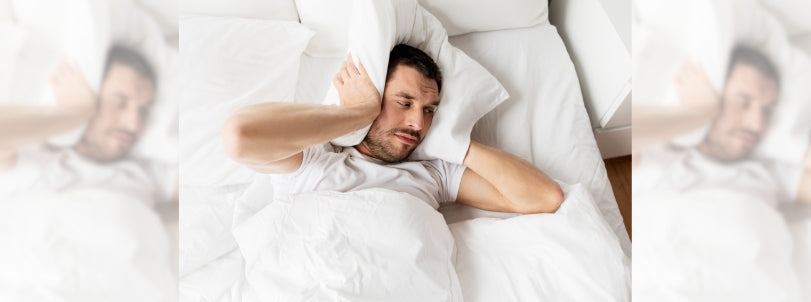
Tips to Make Your CPAP Quieter at Night
Modern APAP, BiPAP or CPAP devices often have sound ratings under 30 decibels, akin to a whispered conversation. However, for light sleepers, this may still be enough to disturb sleep and impact the effectiveness of their obstructive sleep apnea treatment.
Keeping your CPAP quiet can also make for an easier adjustment when first starting PAP therapy. A bed partner may be none too pleased either if their sleep is disturbed by an APAP, BiPAP or CPAP that isn’t quiet enough. PAP devices can also become noisier over time.
The following are tips to help keep your CPAP quiet and promote a peaceful bedroom environment.
1. Check CPAP Device Placement
The simplest check to maintain a quiet CPAP device noise level is where and how it is positioned. The device should be placed lower than your ear level to ensure any sound is not directly in line with your ears.
However, the device should not be placed on the floor as this can block airflow. Ideally, the device will be placed on a lower shelf of a bedside table or stool, somewhere stable and free of dust. An anti-vibration mat will help absorb vibrations when the device is positioned on a hard surface.
2. Check for Air Leaks
Air leaks are another common source of APAP, BiPAP or CPAP noise. Air can leak through an ill-fitting mask, while a properly fitted mask not only helps keep CPAP quiet but ensures effective treatment of obstructive sleep apnea.
Work with your healthcare provider to either adjust the mask straps for a more snug fit or to replace the mask with a more suitable, correctly fitting alternative.
3. Maintain CPAP Device
Regular inspection and maintenance of your device and parts will help keep your CPAP quiet. Debris such as dirt particles accumulating in areas like the tubing will cause the device to work harder to deliver the pressurized air. This can create additional noise.
Condensation can also make CPAPs noisier, for which heated tubing is a practical solution. You should also check for small holes or splits in the tubing and mask when cleaning. Any imperfections in the device can cause air to leak and increase your CPAP device noise level.
If you continue to experience higher levels of sound while the air moves through the tubing, an inline muffler may offer a solution, although not every device will be compatible.
4. Keep to the Schedule on Parts Replacement
CPAP manufacturers will issue guidelines on how often you should replace parts, including the mask cushion, mask frame, tubing and humidifier chamber. In the spirit of “prevention is better than cure”, maintaining the schedule helps prevent potential noise issues from CPAP parts before they arise.
Air filters also need to be included in this schedule. The filters are key to trapping dust, dirt, and allergens before the air is delivered along the tubing to the mask. Clogged filters can create more noise as the device’s motor works harder to compensate.
Regularly replacing filters can also extend the lifespan of the device as well as ensure healthier obstructive sleep apnea treatment.
5. Invest in a Newer Device
An old CPAP device can become noisier over time. CPAP therapy is required every night to prevent the return of your obstructive sleep apnea symptoms, and keeping your CPAP quiet can become difficult if the motor degrades as a result of wear and tear through constant use.
The technology underlying APAP, BiPAP and CPAP therapy continues to develop, and modern devices are much quieter than their predecessors. The noise emitted by most devices is hardly a whisper now. Therefore, if your current device has served you well but is becoming noticeably noisier, it could be time to upgrade to a newer, quieter model.
6. Check the Humidifier Water Level
Most modern APAP, BiPAP and CPAP devices come with a heated humidifier. The moist, warm air supplied by a humidifier adds a level of comfort that many users will appreciate. Without a humidifier, you can wake in the morning with nasal congestion or a dry mouth from the dry air inhaled as you sleep.
However, if your humidifier starts to make gurgling sounds or bubbling noises, then you will want to check the water level in the chamber. Such noises can result from the water level being too high or low.
Check the humidity level settings too, as an incorrect setting can cause the humidity level to start to fluctuate – adding to the CPAP device noise level.
7. Try a White Noise Device
If the low-level sound produced by CPAP affects your ability to sleep, a white noise device may offer a solution.
While it may seem like you are replacing one noise with another, the consistent, calming nature of the sounds from a white noise device are designed to soothe rather than irritate. White noise devices come in different styles and with a variety of different sound effects to lull you into sleep. Replicating certain sounds from nature like falling raindrops or gentle ocean waves can promote sleep and improve your sleep apnea treatment through less sleep disruption.
8. Opt for Tried and Tested Methods
Earplugs are a tried and tested noise cancellation method. Noise canceling earphones may also be an option. However, as with most things, it will not be a viable option for everyone. Earplugs can be uncomfortable, particularly if you tend to move around a lot in your sleep. Some individuals like to have a fan running in their room, where the sound can serve as a form of white noise.
Maintaining your CPAP device and replacing parts as scheduled will help to keep your CPAP quiet and reduce noise to a minimum. If noise is still an issue, checking your mask fits correctly, or investing in an accessory like a white noise device can remove or mask nuisance noise to improve your sleep.
